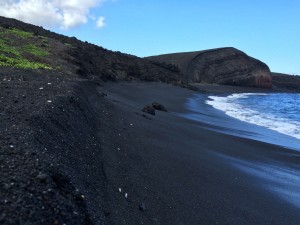Hawai‘i has almost as many colors of sand on its beaches as Matsumoto’s Shave ice has flavors of shave ice (not really, but you get the idea.) White, black, green, and even red sand beaches can all be found here. Each of these colors and beaches were formed from different materials and give each it’s own character and feel.
Most of the black sand beaches in Hawai‘i are located on the Big Island. The reason for this is because it is the only island that still has an active volcano. The black sand is formed when molten lava hits the cool ocean water and explodes, sending tiny pieces of basalt in all directions. This black cooled lava rolls around in the ocean and gets broken up even smaller and eventually deposits onto the shore, creating a beach. These beaches are short lived, only a couple of hundred years. Once the lava stops flowing, no more sand is created, and the ocean eventually washes it away. Punalu‘u beach on the Big Island is a superb example of a black sand beach. Green sand beaches are mostly Olivine, a semi-precious gemstone (the only one found in Hawai‘i). The ocean’s waves and tides grind away at the lava rock and gemstone coastline, eventually creating a dark green sand. Papakolea beach on Big Island is the best example of green sand beach in Hawai‘i. There’s no shortage of red earth in Hawai‘i, but red sand is harder to find. The best example of a red sand beach is at Kaihalulu bay, on Maui. Red sand is made from rock with a high iron content. Basically the beach is rusty. It’s a unique experience, a must see on Maui. Most white sand beaches in the world are made from quartz minerals. Hawai‘i, geologically speaking, is too young to have a source of quartz. Instead, the white sand is made from the carbonate shells of marine organisms, such as coral skeletons and seashells. Over time the ocean grinds them into fine white sand. Lanikai Beach on Oahu is a stunning white sand beach. There is also one fish in particular that makes a unique contribution to the formation of these beaches. A large parrot fish, or uhu as it’s known locally, can produce around 800 lbs. of sand a year, according to the University of Hawai‘i. It uses its sharp beak to break pieces of coral from the reef, but it’s not after the hard carbonate mineral structure of the reef itself. It can only digest the algae living on the coral. So what’s left over, comes out the other side as sand. The jokes are endless, we’ll leave them to you…it’s too easy. Not only are the rainbows more colorful in Hawai‘i, the beaches are too. Now you know why.

Andrew Doughty is the famous author of the widely popular Hawaii Revealed series including Kauai Revealed, Oahu Revealed, Maui Revealed and the Big Island Revealed. He moved to Kauai many years ago after he fell in love with the beauty of the islands and decided to never go back. He is known for his candid opinion on each of Hawaii’s attractions, be it a restaurant, a helicopter ride, a beach or a resort. For the last two decades, he has managed to keep his identity anonymous so that his reviews can remain unbiased and only be influenced by his own opinions and thoughts. You can learn more about his beautiful journey at this link – About the author


0 Comments